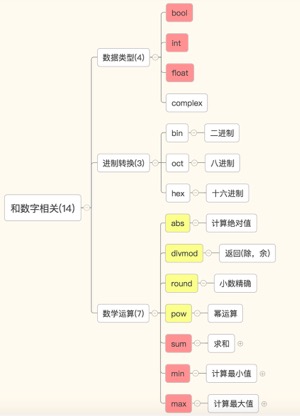函数(六)——内置函数大全(一)
一、内置函数
1)作用域相关
基于字典的形式获取局部变量和全局变量
globals()——获取全局变量的字典
locals()——获取执行本方法所在命名空间内的局部变量的字典
2)迭代器/生成器相关
next:
迭代器.__next__()
next(迭代器)
iter:
迭代器 = iter(可迭代的)
迭代器 = 可迭代的.__iter__()
range:
range(10)
range(1,11)
print('__next__' in dir(range(1,11,2)))
3)其他
字符串类型代码的执行
eval(): 将字符串类型的代码执行并返回结果
print(eval('1+2+3+4'))
exec():将自字符串类型的代码执行
print(exec("1+2+3+4"))
exec("print('hello,world')")
code = '''
import os
print(os.path.abspath('.'))
'''
code = '''
print(123)
a = 20
print(a)
'''
a = 10
exec(code,{'print':print},)
print(a)
指定global参数
compile:将字符串类型的代码编译。代码对象能够通过exec语句来执行或者eval()进行求值。
参数说明:
1. 参数source:字符串或者AST(Abstract Syntax Trees)对象。即需要动态执行的代码段。
2. 参数 filename:代码文件名称,如果不是从文件读取代码则传递一些可辨认的值。当传入了source参数时,filename参数传入空字符即可。
3. 参数model:指定编译代码的种类,可以指定为 ‘exec’,’eval’,’single’。当source中包含流程语句时,model应指定为‘exec’;当source中只包含一个简单的求值表达式,model应指定为‘eval’;当source中包含了交互式命令语句,model应指定为'single'。
>>> #流程语句使用exec
>>> code1 = 'for i in range(0,10): print (i)'
>>> compile1 = compile(code1,'','exec')
>>> exec (compile1)
3
7
>>> #简单求值表达式用eval
>>> code2 = '1 + 2 + 3 + 4'
>>> compile2 = compile(code2,'','eval')
>>> eval(compile2)
>>> #交互语句用single
>>> code3 = 'name = input("please input your name:")'
>>> compile3 = compile(code3,'','single')
>>> name #执行前name变量不存在
Traceback (most recent call last):
File "<pyshell#29>", line 1, in <module>
name
NameError: name 'name' is not defined
>>> exec(compile3) #执行时显示交互命令,提示输入
please input your name:'pythoner'
>>> name #执行后name变量有值
"'pythoner'"
输入输出
input() 输入
s = input("请输入内容 : ") #输入的内容赋值给s变量
print(s) #输入什么打印什么。数据类型是str
print() 输出

def print(self, *args, sep=' ', end='\n', file=None): # known special case of print
"""
print(value, ..., sep=' ', end='\n', file=sys.stdout, flush=False)
file: 默认是输出到屏幕,如果设置为文件句柄,输出到文件
sep: 打印多个值之间的分隔符,默认为空格
end: 每一次打印的结尾,默认为换行符
flush: 立即把内容输出到流文件,不作缓存
"""
print源码剖析

f = open('tmp_file','w')
print(123,456,sep=',',file = f,flush=True)

import time
for i in range(0,101,2):
time.sleep(0.1)
char_num = i//2 #打印多少个'*'
per_str = '\r%s%% : %s\n' % (i, '*' * char_num) if i == 100 else '\r%s%% : %s'%(i,'*'*char_num)
print(per_str,end='', flush=True)
#小越越 : \r 可以把光标移动到行首但不换行
打印进度条
内存相关
id(o) o是参数,返回一个变量的内存地址
hash(o) o是参数,返回一个可hash变量的哈希值,不可hash的变量被hash之后会报错。

t = (1,2,3)
l = [1,2,3]
print(hash(t)) #可hash
print(hash(l)) #会报错
'''
结果:
TypeError: unhashable type: 'list'
'''
hash实例
hash函数会根据一个内部的算法对当前可hash变量进行处理,返回一个int数字。
*每一次执行程序,内容相同的变量hash值在这一次执行过程中不会发生改变。
数据类型相关
type(o) 返回变量o的数据类型
文件操作相关
open() 打开一个文件,返回一个文件操作符(文件句柄)
操作文件的模式有r,w,a,r+,w+,a+ 共6种,每一种方式都可以用二进制的形式操作(rb,wb,ab,rb+,wb+,ab+)
可以用encoding指定编码.
模块相关
__import__导入一个模块

import time

os = __import__('os')
print(os.path.abspath('.'))
帮助方法
在控制台执行help()进入帮助模式。可以随意输入变量或者变量的类型。输入q退出
或者直接执行help(o),o是参数,查看和变量o有关的操作。。。
和调用相关
callable(o),o是参数,看这个变量是不是可调用。
如果o是一个函数名,就会返回True

def func():pass
print(callable(func)) #参数是函数名,可调用,返回True
print(callable(123)) #参数是数字,不可调用,返回False
查看参数所属类型的所有内置方法

print(dir(list)) #查看列表的内置方法 print(dir(int)) #查看整数的内置方法
4)基础数据类型相关
和数字相关

数字——数据类型相关:bool,int,float,complex
数字——进制转换相关:bin,oct,hex
数字——数学运算:abs,divmod,min,max,sum,round,pow



